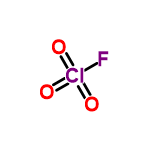Fluorochlorane trioxide ClFO3 structure – Flashcards
Flashcard maker : Elizabeth Bates
Contents

| Molecular Formula | ClFO3 |
| Average mass | 102.450 Da |
| Density | |
| Boiling Point | |
| Flash Point | |
| Molar Refractivity | |
| Polarizability | |
| Surface Tension | |
| Molar Volume |
- Experimental data
- Predicted – ACD/Labs
- Predicted – EPISuite
- Predicted – ChemAxon
- Experimental Physico-chemical Properties
- Miscellaneous
Predicted data is generated using the ACD/Labs Percepta Platform – PhysChem Module
| Density: | |
| Boiling Point: | |
| Vapour Pressure: | |
| Enthalpy of Vaporization: | |
| Flash Point: | |
| Index of Refraction: | |
| Molar Refractivity: | |
| #H bond acceptors: | 3 |
| #H bond donors: | 0 |
| #Freely Rotating Bonds: | 0 |
| #Rule of 5 Violations: |
| ACD/LogP: | |
| ACD/LogD (pH 5.5): | |
| ACD/BCF (pH 5.5): | |
| ACD/KOC (pH 5.5): | |
| ACD/LogD (pH 7.4): | |
| ACD/BCF (pH 7.4): | |
| ACD/KOC (pH 7.4): | |
| Polar Surface Area: | 51 Å2 |
| Polarizability: | |
| Surface Tension: | |
| Molar Volume: |
Predicted data is generated using the US Environmental Protection Agency’s EPISuite™
Log Octanol-Water Partition Coef (SRC): Log Kow (KOWWIN v1.67 estimate) = -3.22 Boiling Pt, Melting Pt, Vapor Pressure Estimations (MPBPWIN v1.42): Boiling Pt (deg C): 441.16 (Adapted Stein & Brown method) Melting Pt (deg C): 148.64 (Mean or Weighted MP) VP(mm Hg,25 deg C): 4.51E-008 (Modified Grain method) Subcooled liquid VP: 8.14E-007 mm Hg (25 deg C, Mod-Grain method) Water Solubility Estimate from Log Kow (WSKOW v1.41): Water Solubility at 25 deg C (mg/L): 1e+006 log Kow used: -3.22 (estimated) no-melting pt equation used Water Sol Estimate from Fragments: Wat Sol (v1.01 est) = 65242 mg/L ECOSAR Class Program (ECOSAR v0.99h): Class(es) found: Neutral Organics Henrys Law Constant (25 deg C) [HENRYWIN v3.10]: Bond Method : Incomplete Group Method: 2.45E-002 atm-m3/mole Henrys LC [VP/WSol estimate using EPI values]: 6.080E-015 atm-m3/mole Log Octanol-Air Partition Coefficient (25 deg C) [KOAWIN v1.10]: Can Not Estimate (can not calculate HenryLC) Probability of Rapid Biodegradation (BIOWIN v4.10): Biowin1 (Linear Model) : 0.6988 Biowin2 (Non-Linear Model) : 0.8255 Expert Survey Biodegradation Results: Biowin3 (Ultimate Survey Model): 2.9728 (weeks ) Biowin4 (Primary Survey Model) : 3.6999 (days-weeks ) MITI Biodegradation Probability: Biowin5 (MITI Linear Model) : 0.4247 Biowin6 (MITI Non-Linear Model): 0.0119 Anaerobic Biodegradation Probability: Biowin7 (Anaerobic Linear Model): 0.8361 Ready Biodegradability Prediction: NO Hydrocarbon Biodegradation (BioHCwin v1.01): Structure incompatible with current estimation method! Sorption to aerosols (25 Dec C)[AEROWIN v1.00]: Vapor pressure (liquid/subcooled): 0.000109 Pa (8.14E-007 mm Hg) Log Koa (): not available Kp (particle/gas partition coef. (m3/ug)): Mackay model : 0.0276 Octanol/air (Koa) model: not available Fraction sorbed to airborne particulates (phi): Junge-Pankow model : 0.5 Mackay model : 0.689 Octanol/air (Koa) model: not available Atmospheric Oxidation (25 deg C) [AopWin v1.92]: Hydroxyl Radicals Reaction: OVERALL OH Rate Constant = 0.0000 E-12 cm3/molecule-sec Half-Life = ------- Ozone Reaction: No Ozone Reaction Estimation Fraction sorbed to airborne particulates (phi): 0.594 (Junge,Mackay) Note: the sorbed fraction may be resistant to atmospheric oxidation Soil Adsorption Coefficient (PCKOCWIN v1.66): Koc : 48.64 Log Koc: 1.687 Aqueous Base/Acid-Catalyzed Hydrolysis (25 deg C) [HYDROWIN v1.67]: Rate constants can NOT be estimated for this structure! Bioaccumulation Estimates from Log Kow (BCFWIN v2.17): Log BCF from regression-based method = 0.500 (BCF = 3.162) log Kow used: -3.22 (estimated) Volatilization from Water: Henry LC: 0.0245 atm-m3/mole (estimated by Group SAR Method) Half-Life from Model River: 1.057 hours Half-Life from Model Lake : 96.4 hours (4.017 days) Removal In Wastewater Treatment: Total removal: 90.51 percent Total biodegradation: 0.02 percent Total sludge adsorption: 0.39 percent Total to Air: 90.09 percent (using 10000 hr Bio P,A,S) Level III Fugacity Model: Mass Amount Half-Life Emissions (percent) (hr) (kg/hr) Air 44.7 1e+005 1000 Water 51 360 1000 Soil 4.26 720 1000 Sediment 0.0932 3.24e+003 0 Persistence Time: 167 hr
Click to predict properties on the Chemicalize site


